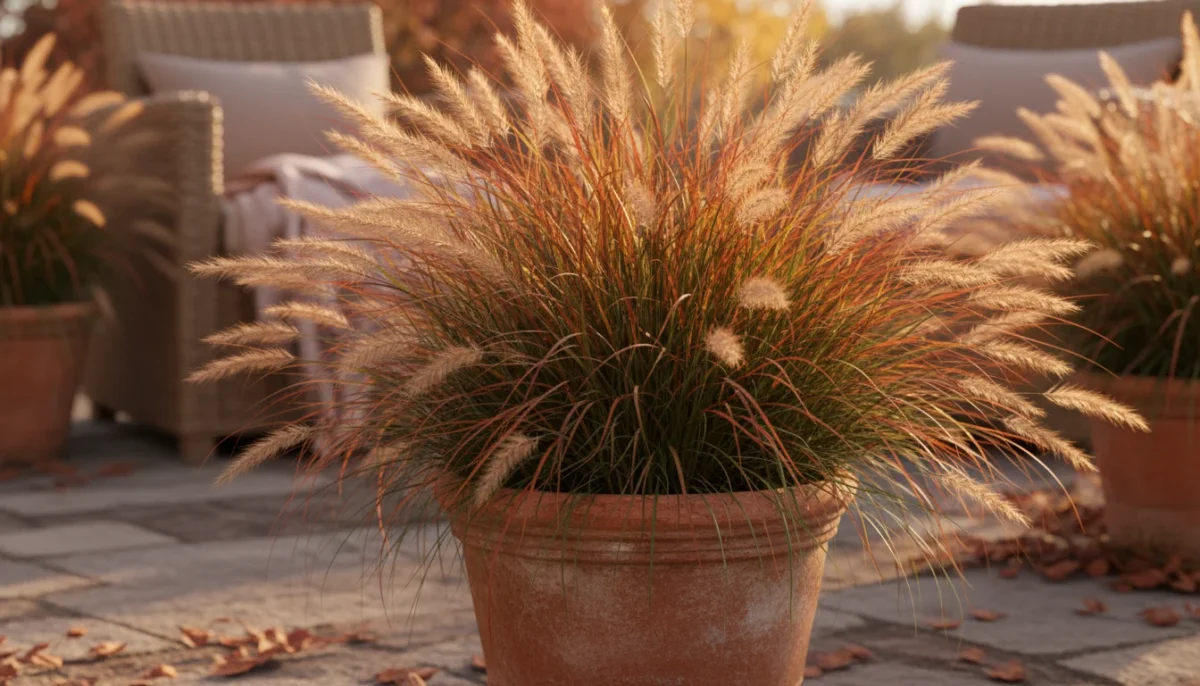As the vibrant hues of summer gardens begin to fade, many gardeners traditionally turn to mums and pansies for their fall container displays. While these classics offer undeniable charm, there is an entire world of dynamic, graceful, and incredibly resilient plants waiting to transform your autumn arrangements. This fall, let us move beyond the expected and explore the remarkable beauty of ornamental grasses in your container designs. These plants offer unparalleled texture, captivating movement, and a sophistication that can elevate any small space, from a bustling balcony garden to a quiet patio nook. You will discover how easy it is to create stunning, low maintenance fall pots that bring long-lasting visual interest and a unique elegance to your outdoor areas.
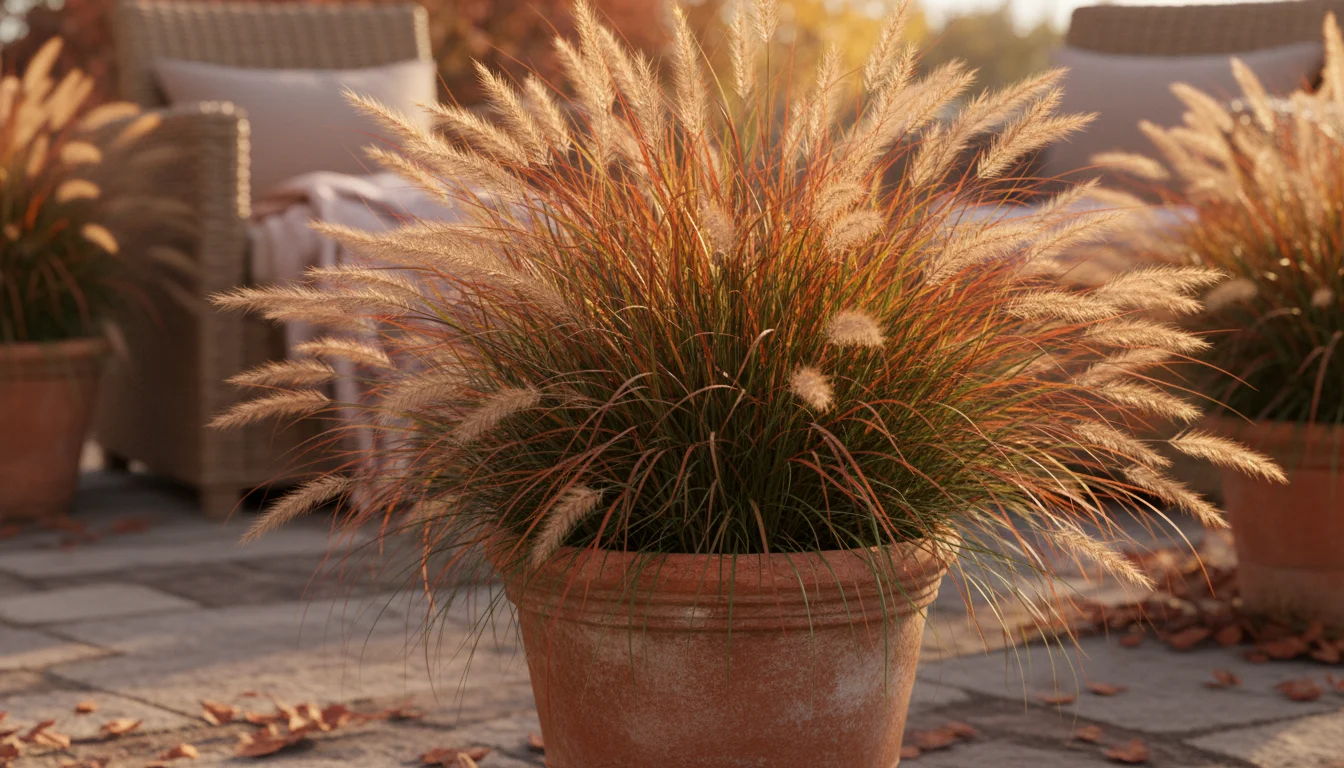
The Unsung Heroes of Fall: Why Ornamental Grasses for Your Containers?
Ornamental grasses are not just garden plants, they are living sculptures that infuse a unique dimension into your outdoor space. Unlike many annual flowers that peak and then decline, ornamental grasses often truly shine in the cooler temperatures of autumn, showcasing their most brilliant colors and seed heads. You might be wondering why you should choose these over traditional fall flowers for your fall container design. The reasons are compelling.
First, consider their incredible **texture**. From the fine, hair-like blades of some fescues to the broad, ribbon-like leaves of certain sedges, grasses offer a tactile richness that other plants struggle to match. This texture adds depth and visual interest, especially important in small-space gardening where every element counts. Imagine the contrast between a smooth, modern container and the feathery plumes of a fountain grass. This interplay creates immediate appeal.
Second, and perhaps most captivating, is their **movement**. Mums stand static, but ornamental grasses dance. Even a gentle breeze brings them to life, creating a graceful, undulating motion that is incredibly soothing and dynamic. This movement adds a lively, ever-changing element to your balcony garden ideas, making your containers feel alive and engaging. This kinetic quality is a hallmark of designing with grasses, providing a naturalistic feel that grounds your small garden in its surroundings.
Third, ornamental grasses are renowned for their **low maintenance** nature, a significant advantage for anyone seeking low maintenance fall pots. Once established, many varieties are remarkably drought tolerant, requiring less frequent watering than thirsty annuals. They generally do not demand deadheading, a task that can quickly become tedious with flowering plants. This translates to more time enjoying your garden and less time working in it. For those with busy schedules or limited gardening experience, this aspect alone makes them an excellent choice.
Fourth, their **seasonal interest** extends well beyond the typical fall blooming period. Many ornamental grasses maintain their structural integrity and beautiful seed heads deep into winter, providing continued visual appeal even after the first hard frosts. Their autumnal colors range from rich golds and coppers to deep burgundies and bronzes, often intensifying as the days shorten. These enduring qualities mean your fall planter ideas without flowers will offer enjoyment for months, not just weeks.
Finally, embracing ornamental grasses for pots allows you to explore unique aesthetics and move beyond conventional gardening. You can create sophisticated, modern, or even wild and naturalistic looks. This shift opens up a new realm of creative possibilities for your small-space gardening efforts, allowing you to craft a display that truly reflects your personal style and maximizes the beauty of every corner of your patio or balcony.
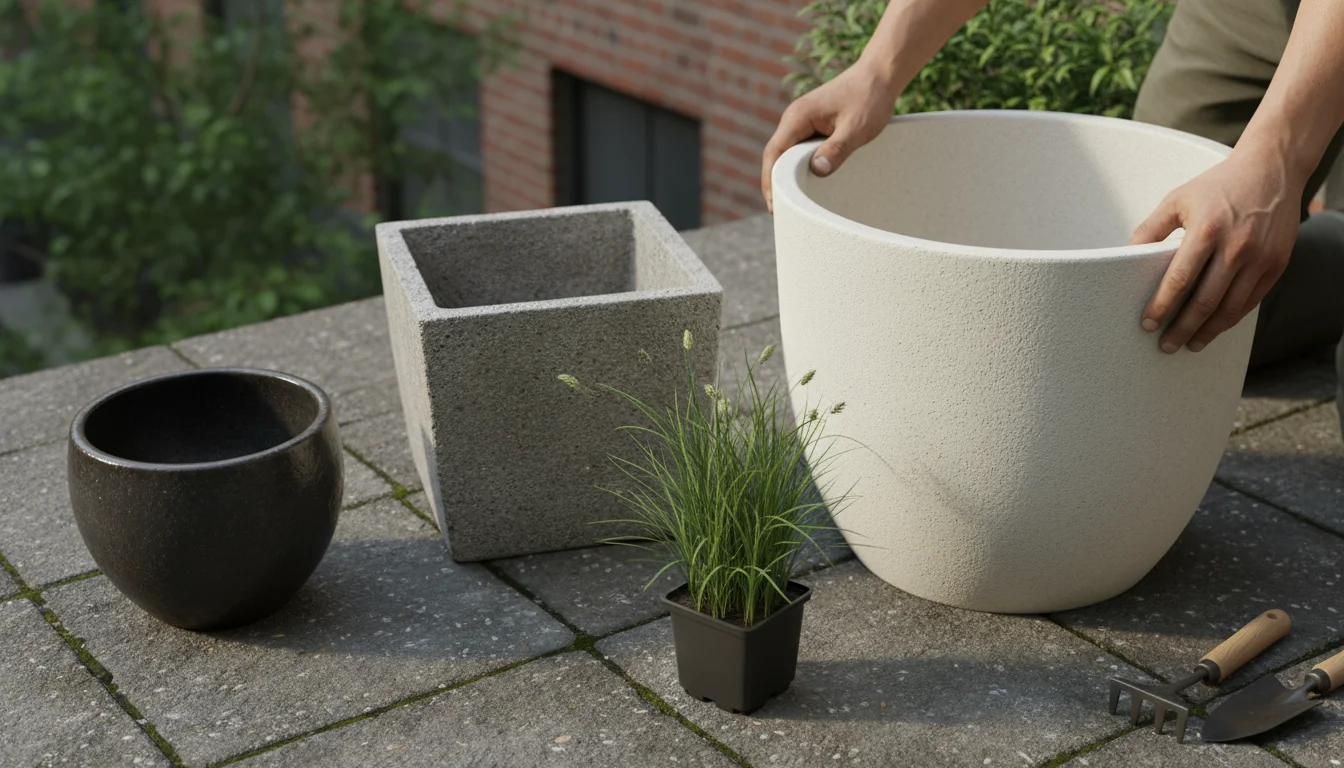
Choosing Your Canvas: Selecting the Right Container for Grasses
Just as an artist selects the perfect canvas, you must choose the right container to showcase the beauty of your ornamental grasses. Your choice impacts not only the aesthetic appeal but also the health and longevity of your plants. This is a critical step in successful fall container design.
The first consideration is **size**. Ornamental grasses, even those labeled “compact,” need adequate room for their root systems to grow. A pot that is too small restricts root development, leading to a stressed plant that struggles to thrive. For a single specimen ornamental grass, aim for a container at least 12 to 18 inches in diameter. If you plan to incorporate multiple grasses or companion plants, a container 18 to 24 inches or larger will provide sufficient space. A larger pot also offers more soil volume, which helps to retain moisture and insulate roots against temperature fluctuations, beneficial for `ornamental grasses for pots`.
Next, consider the **material** of your container. Each material has distinct properties that can influence plant care and overall aesthetics:
- Terracotta or Clay: These porous materials allow air and moisture to pass through, which helps prevent root rot. However, they also dry out faster, requiring more frequent watering, especially in warmer fall conditions. Their classic, earthy look complements most garden styles.
- Plastic: Lightweight and affordable, plastic pots retain moisture well, reducing the need for frequent watering. They are also durable and come in a vast array of colors and styles, making them versatile for `balcony garden ideas`. Just ensure they are made from UV-resistant material to prevent degradation over time.
- Glazed Ceramic: These pots offer excellent moisture retention and come in many decorative finishes, adding a touch of elegance. They can be heavy, however, so consider their placement carefully, particularly for larger sizes.
- Metal (e.g., galvanized steel): Modern and sleek, metal containers can make a bold statement. Be aware that metal can heat up quickly in direct sun, potentially stressing roots. Lining the interior with insulation can help mitigate this.
- Wood: Whiskey barrels or wooden planters offer a rustic charm and provide good insulation. Ensure the wood is rot-resistant or treated, and that the container has adequate drainage.
Regardless of the material, the most crucial feature of any container is **drainage holes**. Without them, water accumulates at the bottom of the pot, suffocating the roots and leading to root rot. Think of drainage as simply how water moves through soil. Your container needs at least one, and preferably several, holes to allow excess water to escape. If your chosen container lacks holes, you must drill them yourself before planting. While some gardeners place a layer of gravel or broken pot shards at the bottom for drainage, modern gardening practice indicates this is often unnecessary and can sometimes even impede proper drainage by creating a perched water table. Instead, focus on using a high-quality potting mix designed for containers.
Finally, consider the **aesthetic** of the container in relation to your chosen grasses and your home’s exterior. A simple, minimalist pot can highlight the intricate beauty of the grasses, while a more ornate container might compete for attention. Choose colors and textures that complement, rather than clash with, the natural hues of your fall grasses. The right container elevates your `fall container design`, turning a simple plant into a focal point.
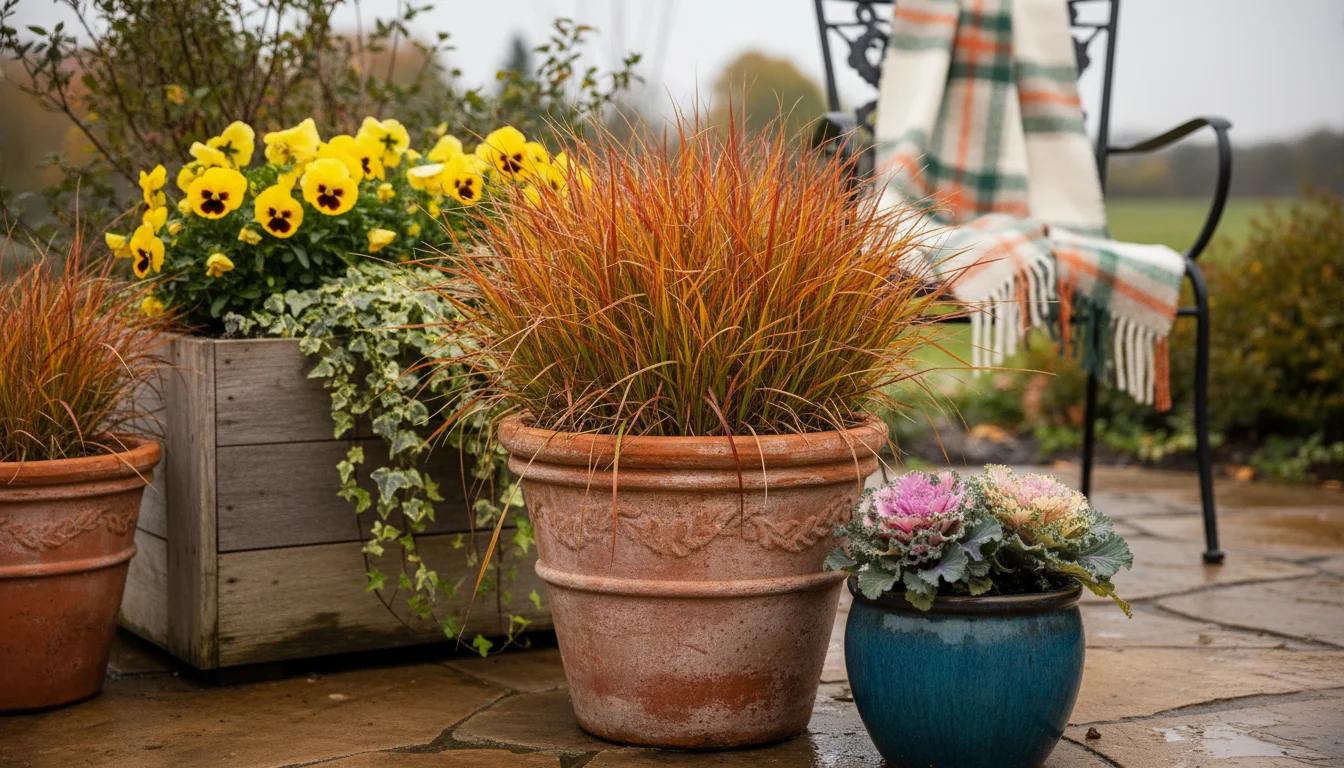
Picking Your Players: Best Ornamental Grasses for Containers in Fall
The world of ornamental grasses is wonderfully diverse, offering a wide array of textures, colors, and sizes perfectly suited for `ornamental grasses for pots`. When selecting varieties for your fall planter ideas without flowers, consider their mature size, light requirements, and how their fall foliage or seed heads will contribute to your design. Here are some of the best ornamental grasses for containers in fall:
- Little Bluestem (Schizachyrium scoparium): This native North American grass is a true showstopper in fall. Its slender, blue-green blades transform into fiery shades of orange, red, and russet as temperatures drop. Growing to about 2-3 feet tall and wide, it maintains an upright, airy habit. Little Bluestem is incredibly drought-tolerant once established and thrives in full sun, making it an excellent choice for a vibrant `fall container design`. Its fine texture and striking color make it an ideal “thriller” or a strong filler.
- Fountain Grass (Pennisetum alopecuroides ‘Hameln’ or ‘Little Bunny’): Known for its graceful, arching form and fluffy, bottlebrush-like plumes, fountain grass adds elegant movement to any container. ‘Hameln’ reaches about 2-3 feet tall and wide, while ‘Little Bunny’ is a dwarf variety, perfect for smaller pots, growing to only 1 foot. The plumes emerge in late summer, often lasting well into winter, and their foliage turns a warm golden-tan in fall. They prefer full sun and moderate water, and are a staple for `low maintenance fall pots` due to their reliable performance.
- Japanese Forest Grass (Hakonechloa macra ‘Aureola’ or ‘All Gold’): For containers in partial to full shade, Japanese Forest Grass is an unparalleled choice. Its cascading habit creates a lush, flowing effect, spilling beautifully over the edge of a pot. ‘Aureola’ features bright green and yellow striped foliage, which often takes on pinkish hues in fall, while ‘All Gold’ offers a vibrant, uniform golden color. Reaching about 1-2 feet tall and wide, it is a fantastic “spiller” or filler, bringing delicate texture and brilliant color to shaded `balcony garden ideas`.
- Sedge (Carex varieties): The genus Carex encompasses a vast range of grass-like plants, many of which are perfect for containers. Varieties like ‘Ice Dance’ (Carex morrowii ‘Ice Dance’) offer striking variegated foliage and remain semi-evergreen in many climates, providing year-round interest. ‘Evergold’ (Carex oshimensis ‘Evergold’) features creamy yellow and green striped leaves with a graceful, mounding habit, typically reaching about 1 foot tall and wide. Sedges generally prefer moist, well-drained soil and can tolerate a range of light conditions from partial sun to shade, making them highly versatile fillers or spillers.
- Switchgrass (Panicum virgatum ‘Shenandoah’ or ‘Heavy Metal’): For a strong vertical element, switchgrass varieties are excellent. ‘Shenandoah’ grows to about 3-4 feet tall and wide, with foliage that starts green and develops brilliant wine-red tips and eventually deep burgundy tones in late summer and fall. ‘Heavy Metal’ offers stunning metallic blue foliage that turns golden in autumn, maintaining a very upright, architectural form. These grasses are extremely tough, drought-tolerant, and prefer full sun. They make impactful “thrillers” in larger `fall container design` arrangements.
- Pink Muhly Grass (Muhlenbergia capillaris): If you want to make a spectacular statement in late fall, Pink Muhly Grass is a must-have. While its foliage is modest, its explosion of airy, cotton-candy pink plumes in October and November is breathtaking. It creates a soft, hazy cloud of color, especially when backlit by the low autumn sun. Growing to about 2-3 feet tall and wide, it thrives in full sun and is very drought-tolerant, providing an ethereal quality to your `fall planter ideas without flowers`.
When making your selections, consider the mature size of the plant, as grasses can grow surprisingly large. Always check the plant tag for specific sun and water requirements to ensure you are placing the right plant in the right spot, ensuring your chosen `ornamental grasses for pots` thrive throughout the fall season and beyond.
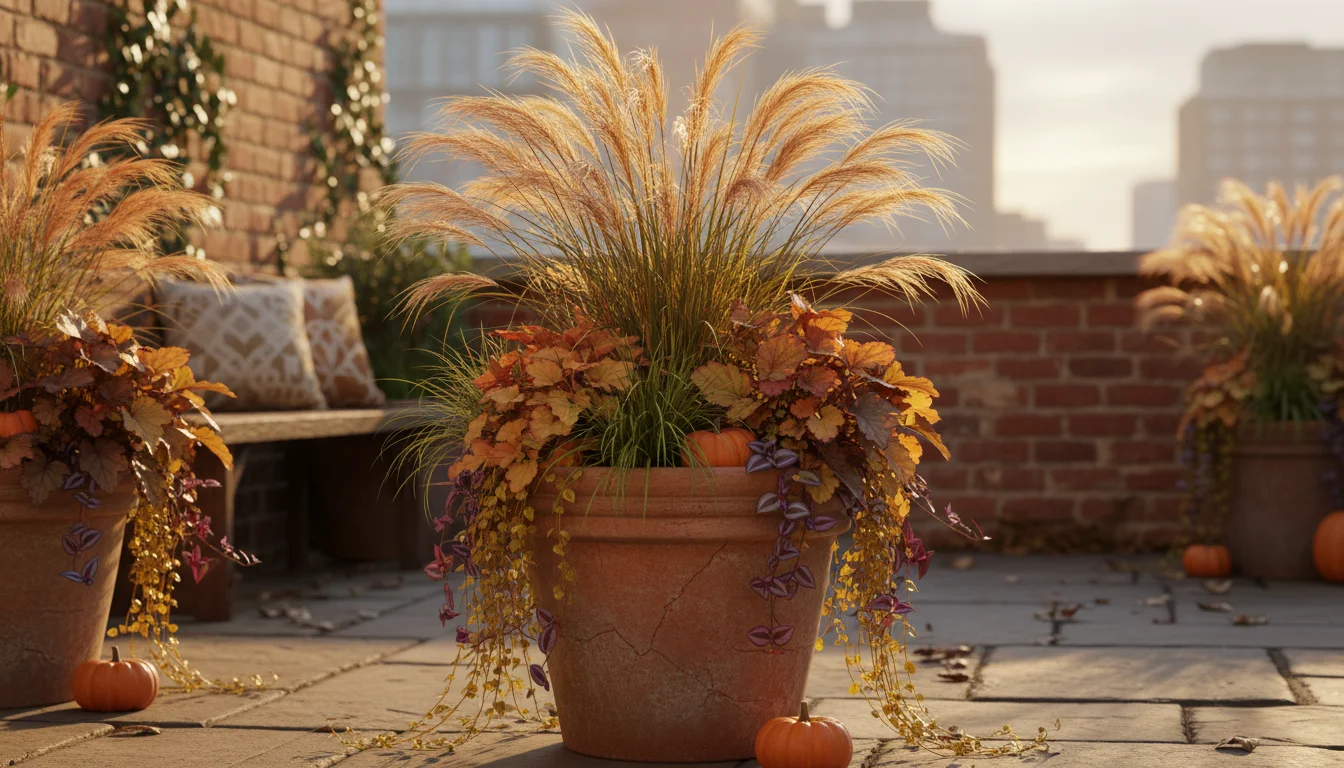
Designing with Dimension: The “Thriller, Filler, Spiller” Approach for Fall
Creating a compelling fall container design with ornamental grasses involves thinking about dimension, texture, and the unique movement these plants provide. A popular and effective design principle, adaptable for small spaces, is the “Thriller, Filler, Spiller” method. This approach ensures your container has visual balance, depth, and consistent interest from all angles. While traditionally used with flowering plants, it translates beautifully to `ornamental grasses for pots`.
The Thriller: The Vertical Anchor
The “thriller” is your focal point, the tallest and most dramatic element in your container. It draws the eye upward and provides a strong vertical line. For ornamental grass containers, your thriller will typically be an upright, stately grass that stands prominently in the center or slightly off-center of your pot. Think of grasses that offer architectural interest, vibrant fall color, or striking seed heads.
- Examples: A tall ‘Shenandoah’ Switchgrass with its burgundy foliage, a sturdy Little Bluestem turning russet, or even a ‘Heavy Metal’ Switchgrass for its blue-gray blades. These choices provide significant height and visual weight, immediately establishing the backbone of your `fall container design`. They command attention and give your arrangement a sense of grandeur.
The Filler: The Middle Ground
The “filler” plants surround the thriller, adding volume, texture, and breadth to the container. They bridge the gap between the tall thriller and the trailing spillers, creating a full, rounded appearance. With grasses, fillers can be mounding varieties, those with interesting foliage colors, or even other textures that complement your main thriller. They should be medium height, about two-thirds the height of your thriller.
- Examples: Mounding Fountain Grass ‘Hameln’ with its soft plumes, various Carex (sedge) varieties like ‘Evergold’ for their variegated foliage, or even a smaller clump of Blue Fescue (Festuca glauca) for its icy blue color. These grasses provide lushness and visual weight without overpowering the thriller. They weave together the composition, adding layers of interest and enriching the texture palette of your `fall planter ideas without flowers`. You can use one large filler or several smaller ones to create a dense, appealing middle layer.
The Spiller: The Cascading Grace
The “spiller” plants are positioned at the edges of the container, designed to cascade and trail over the sides. They soften the hard edges of the pot, connecting the arrangement to its surroundings and creating a more natural, flowing look. For ornamental grass containers, spillers are often grasses or grass-like plants with a weeping or mounding, then trailing habit.
- Examples: Japanese Forest Grass ‘Aureola’ with its bright, arching blades that drape beautifully, or even certain low-growing sedges that spill gently. When choosing spillers for `balcony garden ideas`, consider how they will interact with the railing or edge of your space. Their graceful descent adds a sense of abundance and movement, making the container feel less rigid and more organic.
When applying this framework, consider the interplay of textures. Combine fine-bladed grasses with broader-leaved ones. Mix upright forms with arching and cascading forms to maximize visual dynamism. Think about how the colors will change as the fall progresses. Many grasses intensify their hues with cooler temperatures, offering a evolving display. The movement of the grasses, their sway in the breeze, becomes an integral part of your design, a feature that static flowers simply cannot replicate. Aim for a harmonious blend where each element enhances the others, creating a cohesive and stunning `fall container design`.
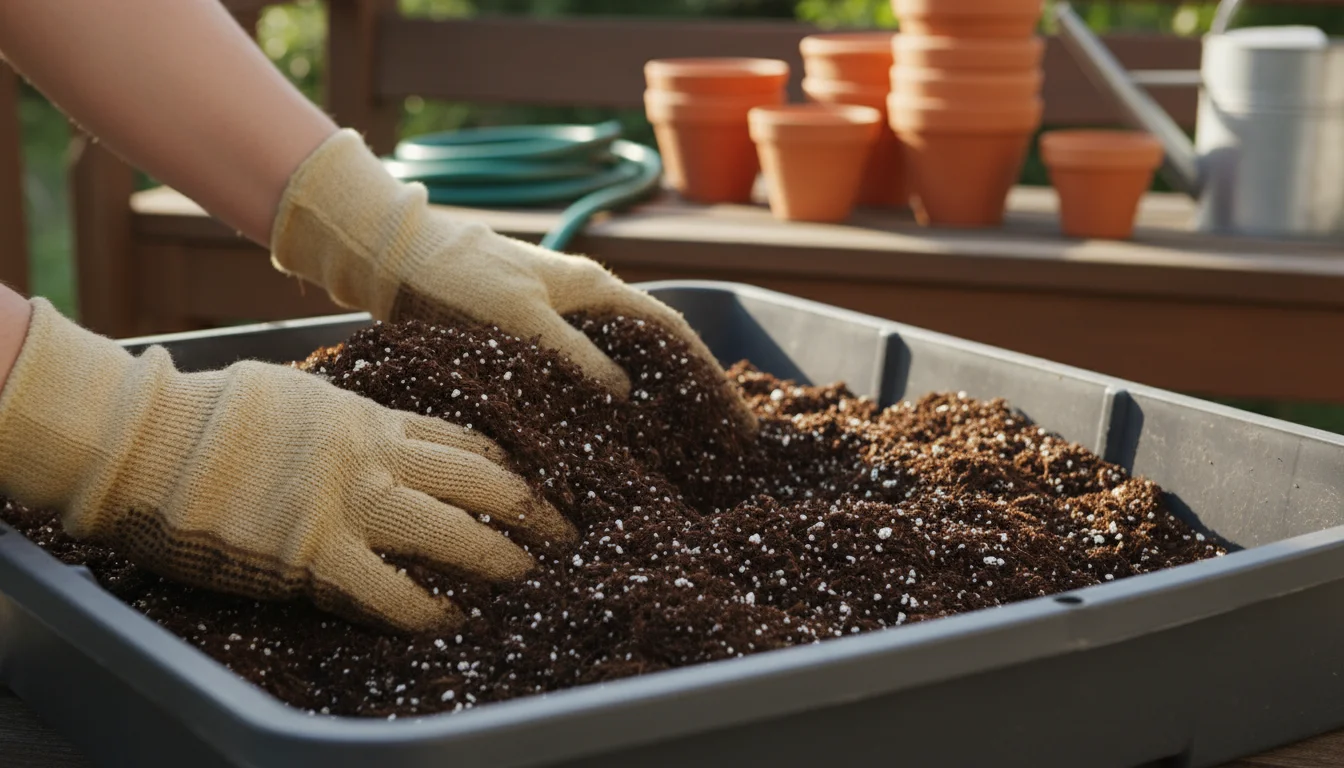
Soil, Water, and Light: Essential Care for Your Fall Grass Containers
Even though ornamental grasses are celebrated for their low maintenance nature, providing them with the right foundation in their container environment is crucial for their success. Understanding their needs for soil, water, and light will ensure your `ornamental grasses for pots` thrive and provide maximum visual impact throughout the fall and into winter.
The Foundation: Soil
The soil in your container is the lifeblood of your plants. For ornamental grasses, you must use a high-quality **potting mix**, not soil dug from your garden. Garden soil is too dense for containers, compacts easily, and does not provide the aeration and drainage that container plants require. Think of aeration as simply allowing air to reach the roots, which is essential for healthy growth. A good potting mix is specifically formulated to be lightweight, well-draining, and capable of retaining moisture and nutrients effectively. It will typically contain a blend of peat moss or coco coir, perlite or vermiculite for drainage, and a base of sterilized soil or compost.
If your chosen grass varieties are known for preferring exceptionally sharp drainage, you can amend your potting mix further. Incorporate an additional 10-20% perlite, small gravel, or coarse sand into the mix. This increases the porosity, ensuring water moves through even more efficiently, preventing the roots from sitting in soggy conditions, which is a common killer of container plants. This simple step helps ensure your `low maintenance fall pots` remain healthy and vibrant.
The Drink: Watering
While many ornamental grasses are drought-tolerant in the ground, containerized plants dry out much faster due to limited soil volume and exposure to air on all sides. Consistent watering is key, especially during establishment and warmer fall days. The best way to determine if your container needs water is to **check the soil moisture**. Stick your finger about two inches deep into the soil. If it feels dry, it is time to water. If it feels moist, wait a day or two and check again.
When you do water, do so thoroughly until you see water draining from the bottom of the pot. This ensures that the entire root ball receives moisture. Avoid frequent, shallow watering, as this encourages surface roots and does not adequately hydrate the deeper roots. Reduce watering frequency as temperatures cool in late fall and early winter, as plants naturally slow their growth and require less moisture. Overwatering is just as detrimental as underwatering, leading to root rot. Balance is important for `fall container design` success.
The Fuel: Light
Most ornamental grasses thrive in **full sun**, meaning at least six hours of direct sunlight per day. Full sun encourages strong, upright growth and intensifies the vibrant fall colors that many varieties develop. If your `balcony garden ideas` involve a sunny exposure, you have a wide range of grasses to choose from, including Little Bluestem, Fountain Grass, Switchgrass, and Pink Muhly Grass.
However, if your space receives partial shade (3-6 hours of sun) or even full shade (less than 3 hours of sun), you still have options. Japanese Forest Grass and many varieties of Sedge (Carex) are excellent choices for shadier locations. Always match your plant selection to the light conditions of your specific site. Attempting to grow a full-sun grass in deep shade will result in leggy, weak growth and poor color development, diminishing the aesthetic appeal of your `fall planter ideas without flowers`.
Minimal Fertilization
Ornamental grasses are generally not heavy feeders. If you use a fresh, high-quality potting mix, it will typically contain enough nutrients to sustain your plants for several weeks, or even months, especially if it includes a slow-release fertilizer. In the fall, as plants prepare for dormancy, you should avoid heavy fertilization. Excess nitrogen can encourage new, tender growth that is vulnerable to early frosts. If you feel your grasses need a boost, a light application of a balanced, all-purpose liquid fertilizer at half strength once a month in early fall is usually sufficient, but often unnecessary for established plants.
By providing the correct soil, mindful watering, and appropriate light conditions, you set your fall grass containers up for spectacular success, ensuring they remain a captivating feature of your small garden for a long season.
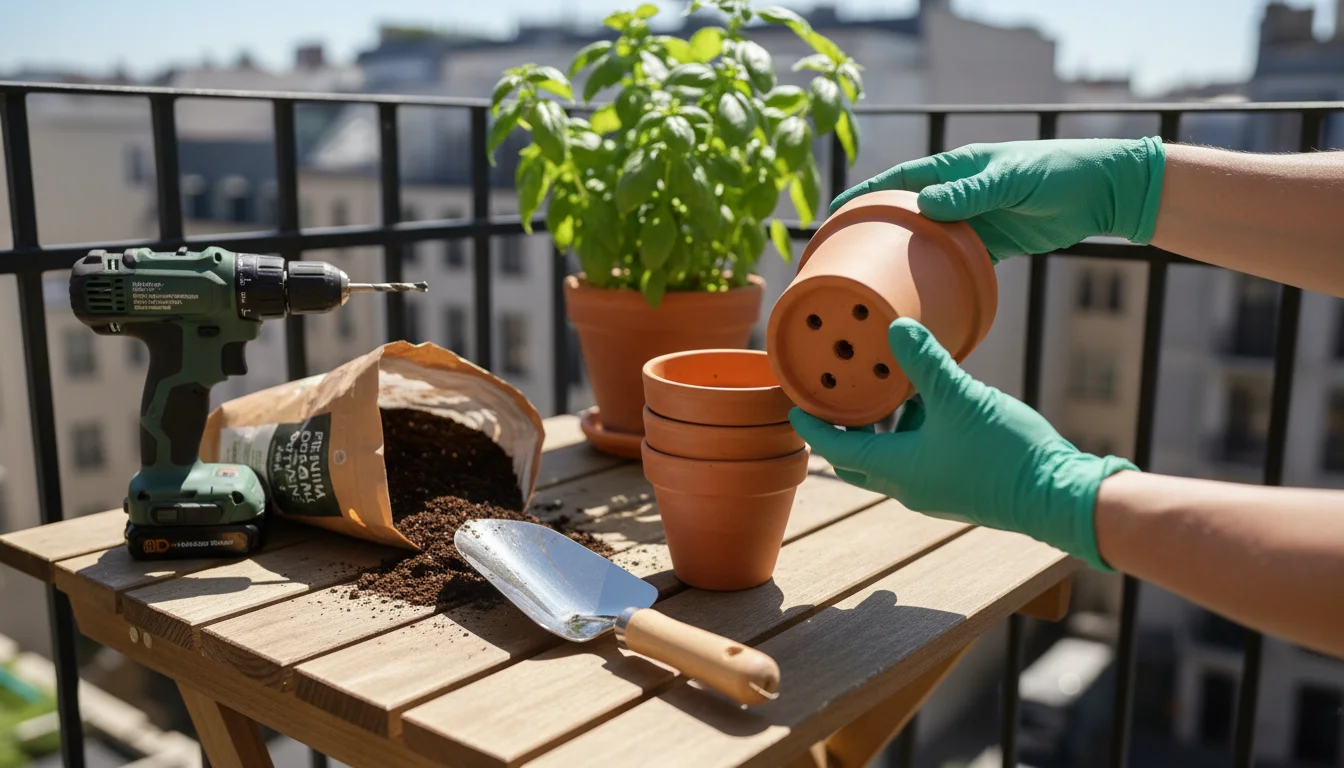
Step-by-Step: Planting Your Fall Grass Container
Creating your stunning fall container with ornamental grasses is a straightforward process. Follow these steps for successful planting and a vibrant display that will last throughout the season. This process is designed to be easy to follow, making your `fall container design` dreams a reality.
-
Gather Your Materials: Before you begin, assemble everything you need:
- Your chosen container with drainage holes.
- High-quality potting mix.
- Your selected ornamental grasses (thriller, filler, spiller).
- Gardening gloves.
- A small trowel.
- Watering can.
- Prepare Your Container: Ensure your container has ample drainage holes. If not, drill them now. While some traditional advice suggests a layer of gravel at the bottom for drainage, it is generally more effective to simply use a good potting mix directly. A piece of landscape fabric or a coffee filter over the drainage holes can prevent soil from washing out while still allowing water to pass through.
- Add Initial Potting Mix: Fill the bottom third to half of your container with fresh potting mix. Gently pat it down, but do not compress it too tightly, as roots need air to thrive. The amount of soil you add here depends on the root ball height of your tallest plant. You want the top of the plant’s root ball to be about 1-2 inches below the rim of the container once planted.
-
Arrange Your Plants: This is where your `fall container design` vision comes to life.
- Start with your “thriller” plant. Place it in the center for a symmetrical design, or towards the back for a container that will be viewed from one side (like against a wall or railing in `balcony garden ideas`). Remove the plant from its nursery pot, gently loosen any circling roots, and position it.
- Next, place your “filler” plants around the thriller. Arrange them to create a full, lush base. Again, remove from nursery pots and gently loosen roots.
- Finally, add your “spiller” plants along the edges of the container, ensuring they have room to cascade over the sides.
- Step back and assess the arrangement from various angles. Adjust the positions of the plants until you are satisfied with the composition. Consider height, texture, and color balance.
- Fill with Potting Mix: Once your plants are arranged, carefully fill the remaining spaces with potting mix. Gently work the soil around and between the root balls of all the plants, ensuring there are no large air pockets. Leave about 1 inch of space between the top of the soil and the rim of the container. This “headroom” allows for easy watering without overflow.
- Water Thoroughly: After planting, water your container generously until you see water draining from the bottom holes. This settles the soil around the roots and eliminates any remaining air pockets. It is a critical step for initial plant establishment.
- Initial Placement and Ongoing Care: Place your newly planted container in its intended location, mindful of its light requirements. Over the next few days, monitor the moisture levels closely. New plantings often need more frequent watering as they adjust to their new home. Your beautifully crafted `fall planter ideas without flowers` will begin to flourish.
By following these steps, you set your ornamental grasses up for success, ensuring a vibrant and appealing display throughout the autumn and often well into the colder months. This methodical approach makes creating `low maintenance fall pots` both rewarding and enjoyable.
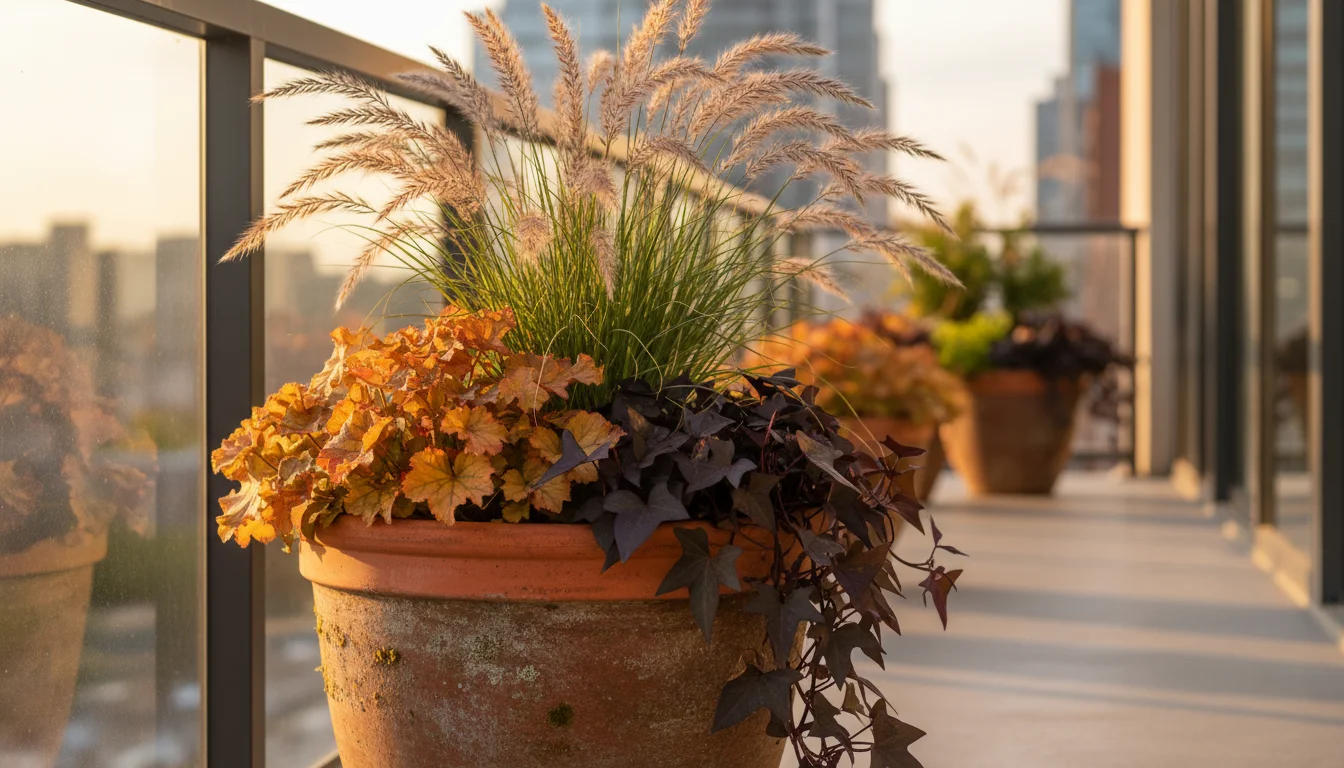
Beyond the Basics: Creative Fall Combinations and Accents
While ornamental grasses are stunning on their own, pairing them with other fall-interest plants and non-plant accents can elevate your containers from beautiful to breathtaking. This approach allows you to explore deeper dimensions in your `fall container design`, creating truly unique displays for your `balcony garden ideas`.
Companion Plants for Enhanced Texture and Color:
When selecting companions, look for plants that offer contrasting textures or complementary fall colors. Remember, the goal is to enhance the grasses, not overpower them. Some excellent choices include:
- Heuchera (Coral Bells): These perennials are fantastic for foliage color, with varieties boasting leaves in shades of burgundy, bronze, lime green, and even deep purple. Their mounding habit makes them excellent fillers, and their delicate flower spikes can add another layer of texture. They thrive in partial shade but many varieties tolerate sun, making them versatile.
- Ornamental Kale and Cabbage: These cold-hardy annuals come into their own with cooler temperatures, developing vibrant centers in shades of pink, purple, white, and green. Their ruffled or smooth leaves provide a bold, architectural contrast to the fine blades of grasses, offering striking `fall planter ideas without flowers` options.
- Sedum ‘Autumn Joy’ or ‘Autumn Fire’: These succulents are famous for their late-season blooms, typically pink, which gradually deepen to rusty red as fall progresses. Their sturdy, upright habit and chunky texture offer a wonderful counterpoint to the airy nature of grasses.
- Violas or Pansies: While this article encourages moving beyond these, a small cluster of violas or pansies can act as a lovely spiller or filler around the base of a grass, offering a pop of traditional fall color without dominating the grass’s presence. Choose varieties in deep purples, oranges, or yellows to tie into the autumnal theme.
- Creeping Jenny (Lysimachia nummularia ‘Aurea’): This vibrant chartreuse-leaved perennial is a classic spiller, offering bright, eye-catching color that cascades over the container’s edge. Its bold hue provides a cheerful contrast to the more subdued tones of many fall grasses.
- Evergreen Groundcovers: Consider low-growing evergreen options like sedums, creeping thyme, or even small euonymus varieties. These provide continuous green or variegated color and can offer a nice textural base around your grasses, lasting through winter.
Non-Plant Accents for Seasonal Flair:
Do not underestimate the power of decorative elements to add personality and visual interest to your fall containers. These accents can reinforce the autumnal theme and provide a touch of charm, helping to complete your `low maintenance fall pots` look.
- Decorative Rocks or Pebbles: A few strategically placed smooth river stones or decorative pebbles can add a natural element, cover bare soil, and provide a pleasing visual weight.
- Small Gourds or Mini Pumpkins: Tucked among the base of the grasses, these quintessential fall elements instantly evoke the season. They are temporary, of course, but easy to refresh throughout autumn.
- Pinecones and Acorns: Gathered from your yard or a local park, these natural treasures add rustic texture and a connection to the outdoor environment.
- Branches or Twigs: For an extra vertical element or a touch of dramatic flair, insert a few decorative branches, such as curly willow or dogwood branches, which can offer interesting color and form even without leaves.
- LED Fairy Lights: As evenings grow longer, a subtle string of battery-operated fairy lights woven through your grasses can create a magical, enchanting glow, transforming your containers into evening focal points.
When combining elements, strive for a cohesive look. Consider color palettes, contrasting forms (e.g., broad leaves next to fine blades), and how the overall arrangement fits with the style of your home and garden. By thoughtfully incorporating companion plants and accents, you can create fall containers that are truly dynamic, beautiful, and uniquely yours.
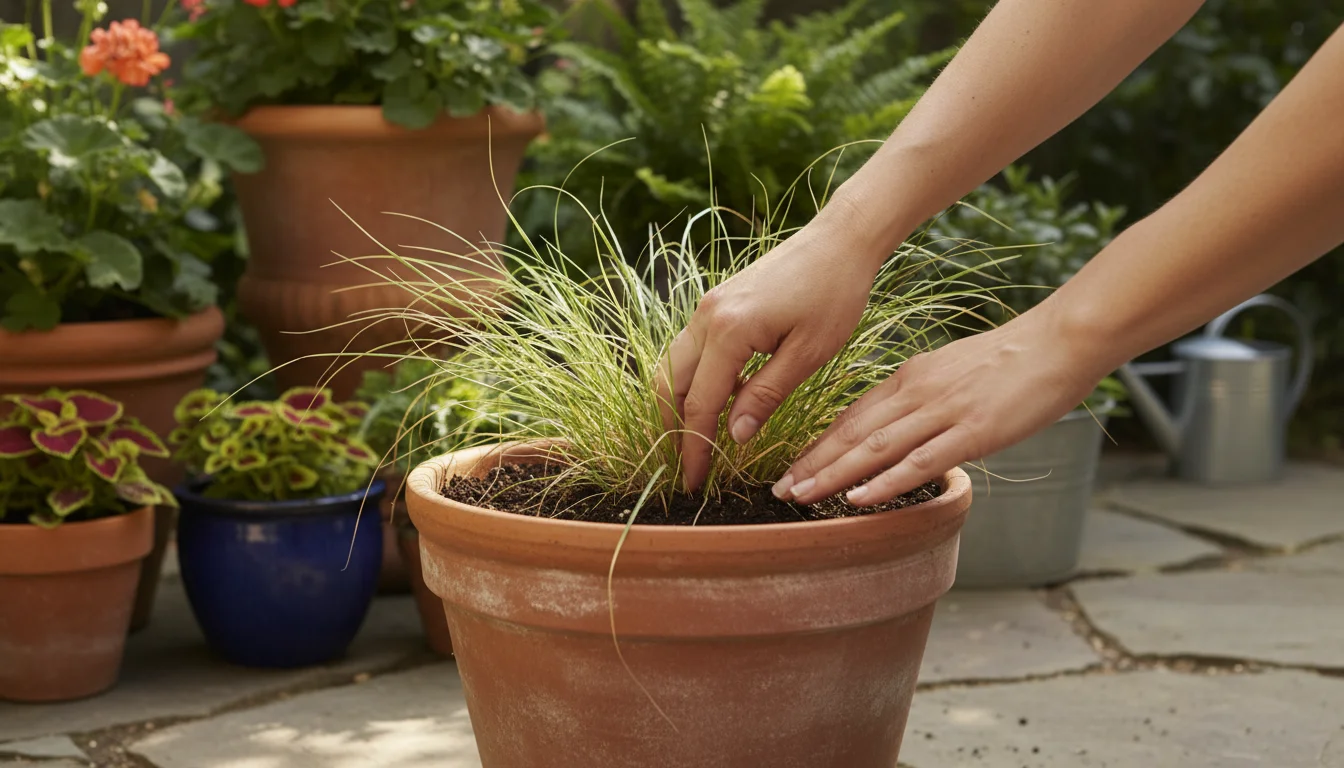
Common Challenges and Troubleshooting Your Grass Containers
Even with their reputation for being low maintenance, ornamental grasses in containers can occasionally present challenges. Understanding common issues and how to troubleshoot them will help you maintain vibrant, healthy `ornamental grasses for pots` throughout the fall season and beyond.
1. Yellowing or Browning Blades:
- Cause: This is the most common symptom of distress and can stem from several issues.
- Overwatering: Too much water suffocates roots, leading to root rot. Leaves turn yellow, then brown, and the plant often looks wilted despite moist soil.
- Underwatering: Insufficient water causes leaves to crisp, turn brown, and curl.
- Nutrient Deficiency: While grasses are not heavy feeders, prolonged container life without fresh soil or occasional feeding can lead to deficiencies.
- Normal Senescence: In fall, many grasses naturally begin to turn yellow or brown as they enter dormancy. This is a natural part of their life cycle and generally not a cause for concern.
- Solution:
- Check Soil Moisture: Stick your finger 2 inches deep. If wet, reduce watering. If dry, water thoroughly. Ensure good drainage.
- Assess Drainage: Confirm your container has adequate drainage holes and that they are not blocked.
- Consider Nutrients: If browning is widespread and not seasonal, a light application of a balanced liquid fertilizer may help, but avoid over-fertilizing in fall.
- Embrace Fall Colors: If the yellowing/browning is uniform and occurring as temperatures drop, simply enjoy the natural autumnal transformation.
2. Leggy or Sparse Growth:
- Cause:
- Insufficient Light: Grasses that prefer full sun will stretch and become sparse when they do not receive enough light, attempting to reach for more sun.
- Container Too Small: Restricted root growth can lead to stunted or weak top growth.
- Solution:
- Relocate: Move your container to a location that provides the appropriate amount of sunlight for your specific grass variety. This is especially important for `balcony garden ideas` where light exposure can be very specific.
- Repot: If the plant is severely root-bound, consider moving it to a larger container next season, or dividing it if appropriate for the species.
3. Pest or Disease Issues:
- Cause: Ornamental grasses are generally robust and resistant to most pests and diseases. When problems do occur, they are often a symptom of underlying stress.
- Aphids or Spider Mites: These tiny pests can sometimes appear, especially on stressed plants.
- Fungal Diseases: Usually a result of excessive moisture, poor air circulation, or overly dense foliage.
- Solution:
- Pest Control: For minor infestations, a strong spray of water can dislodge pests. For persistent issues, use an insecticidal soap, ensuring thorough coverage.
- Disease Management: Improve air circulation by lightly trimming dense foliage if necessary. Ensure proper watering and drainage. Remove affected blades promptly.
- Prevent Stress: Healthy, well-cared-for plants are naturally more resistant to pests and diseases, supporting your goal for `low maintenance fall pots`.
4. Winter Survival Failures:
- Cause: While some grasses are hardy in containers, many struggle to survive winter in pots, especially in colder climates, due to roots freezing more easily than in the ground.
- Solution:
- Choose Hardy Varieties: Select grasses that are hardy to at least two zones colder than your own.
- Insulate Containers: Wrap containers with burlap and fill the space with leaves, or use bubble wrap. You can also place the container inside a larger, insulated container.
- Move Indoors: For less hardy varieties or very cold zones, move pots to an unheated garage, shed, or cool basement. Reduce watering significantly during dormancy.
- Treat as Annuals: Sometimes, the most practical approach for `fall planter ideas without flowers` in very cold regions is to simply enjoy them for the season and compost them, or plant them in the ground next spring.
By staying vigilant and addressing problems promptly, you can ensure your `fall container design` remains a source of beauty and pride throughout the autumn and often well into the winter months.
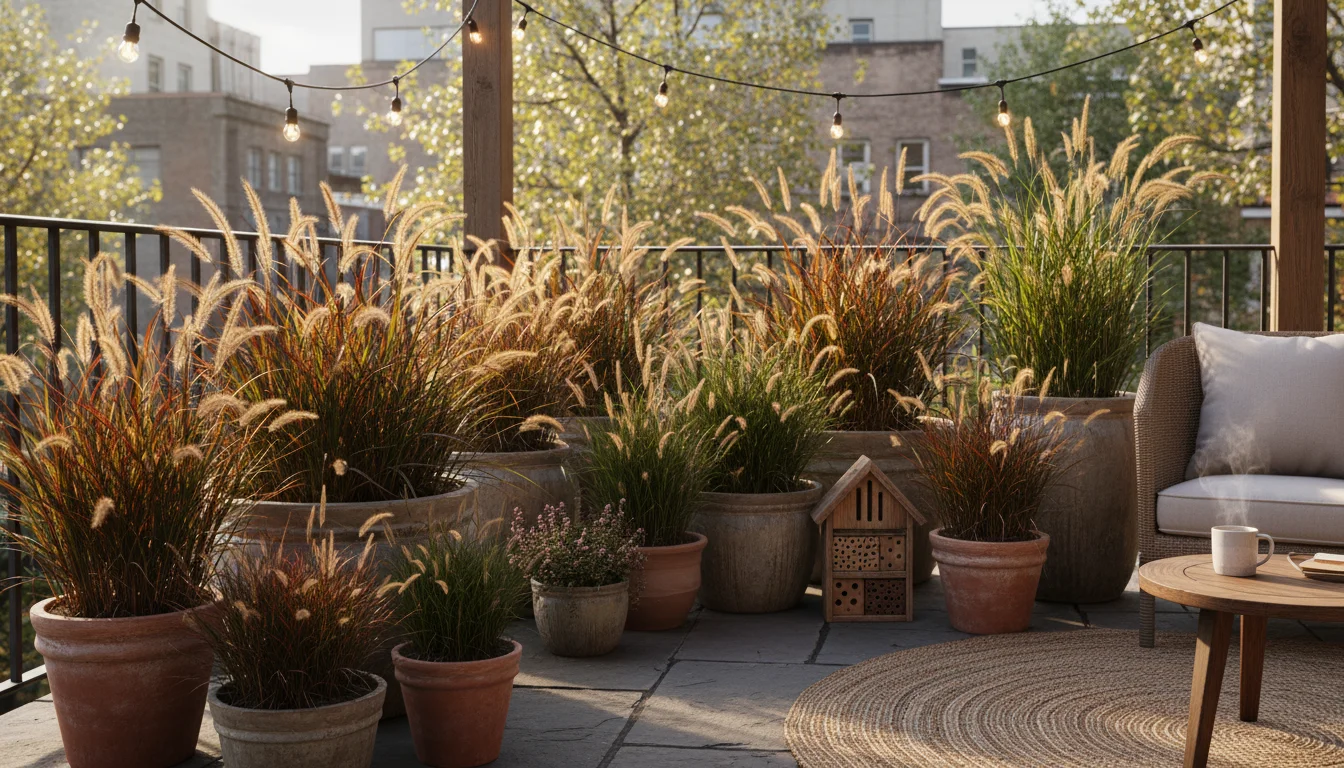
Embracing Sustainability with Your Fall Grass Displays
As gardeners, we have a unique opportunity to contribute positively to the environment, even in small spaces. Designing your fall containers with ornamental grasses lends itself beautifully to sustainable practices. By making conscious choices, you can create beautiful `fall container design`s that are also eco-friendly.
Choose Native Grass Species: Wherever possible, incorporate native ornamental grasses into your `ornamental grasses for pots`. Native plants are adapted to your local climate and soil conditions, requiring less water, fertilizer, and pest control once established. They also provide crucial habitat and food sources for local wildlife, including beneficial insects and birds, contributing to biodiversity in your `balcony garden ideas`.
- Example: Little Bluestem (Schizachyrium scoparium) is a fantastic native grass for many regions of North America, offering stunning fall color and drought tolerance. Researching native grasses specific to your area is a rewarding step towards a more sustainable garden.
Water Conservation: Ornamental grasses are generally more drought-tolerant than many flowering plants, making them a wise choice for water-wise gardening. You can further conserve water by:
- Mulching: Apply a thin layer of organic mulch (like shredded bark or coco coir) on top of the soil in your containers. This helps retain soil moisture, reduces evaporation, and regulates soil temperature.
- Grouping Containers: Cluster your containers together. This creates a microclimate that can reduce water loss from individual pots.
- Collecting Rainwater: If feasible, install a rain barrel to capture rainwater for your container plants. This free, chemical-free water is ideal for your garden.
Reusable and Recycled Containers: Invest in durable, high-quality containers made from materials like ceramic, galvanized metal, or recycled plastic. These can be reused year after year, reducing waste. Avoid single-use plastic pots whenever possible, or ensure you recycle them appropriately if you must use them. Even `low maintenance fall pots` benefit from thoughtful container choices.
Composting Spent Plants: At the end of the season, when it is time to refresh your containers, compost any spent annual grasses or plant material (unless diseased). This returns valuable nutrients to the soil and reduces landfill waste. If you do not have a compost pile, many community gardens or municipal services offer composting options.
Avoid Peat Moss (Where Possible): Peat moss is a common component in potting mixes, but its harvesting can be environmentally damaging. Look for potting mixes that use sustainable alternatives like coco coir, compost, or rice hulls. If peat moss is the only option, choose products from suppliers committed to responsible and sustainable peatland management. Your `fall planter ideas without flowers` can truly be a testament to sustainable gardening practices.
By adopting these sustainable practices, your fall grass containers become more than just beautiful displays. They become a testament to mindful gardening, contributing to the health of your local ecosystem and demonstrating how small actions in your garden can have a positive environmental impact.
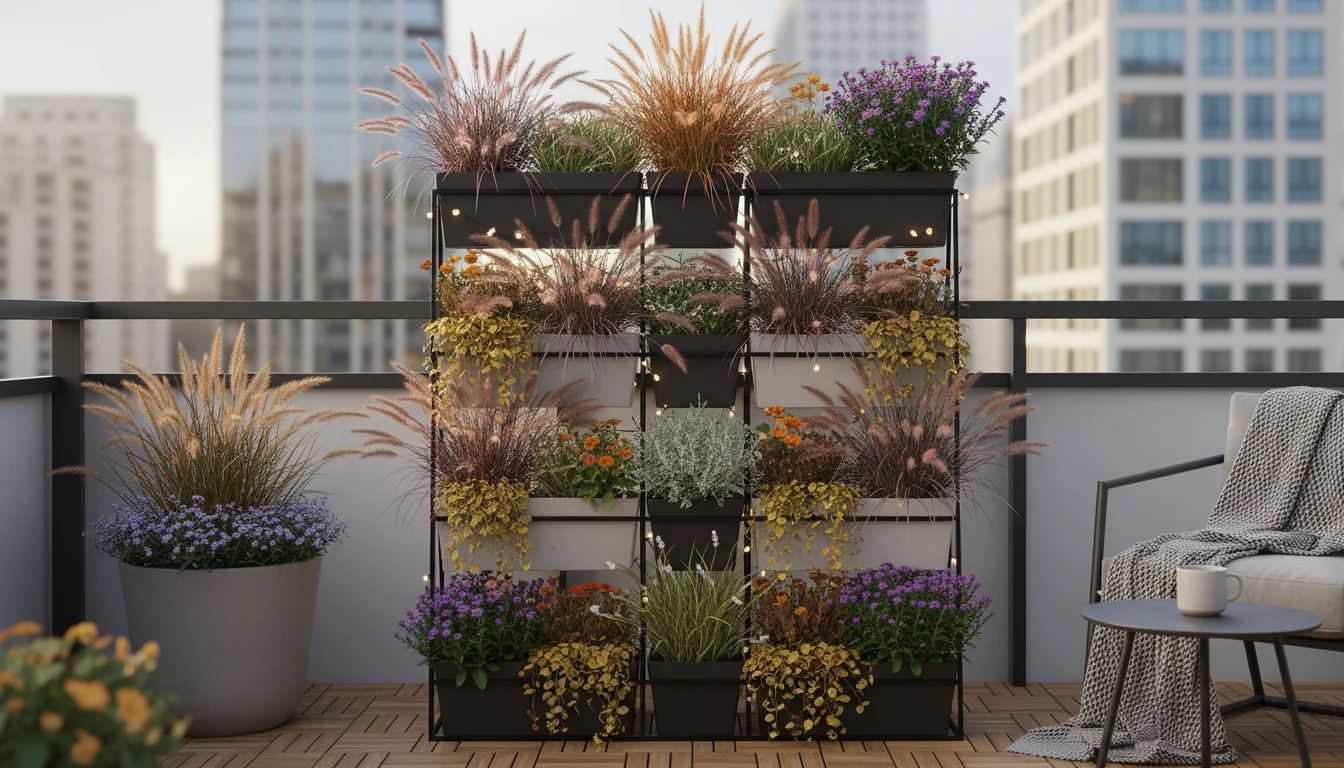
Frequently Asked Questions
Can I leave ornamental grasses in pots over winter?
Whether you can leave ornamental grasses in pots over winter depends on your climate zone and the hardiness of the specific grass variety. In general, plants in containers are less hardy than those planted in the ground because their roots are more exposed to freezing temperatures. If you live in a mild climate (Zones 7 and higher), many hardy grasses will survive winter in containers with minimal protection. In colder zones, you will need to choose grasses that are hardy to at least two zones colder than yours, or provide extra insulation for the pots, such as wrapping them in burlap or bubble wrap. Alternatively, you can move the pots to an unheated garage, shed, or cool basement for dormancy, significantly reducing watering.
Do ornamental grasses need a lot of sun?
Most ornamental grasses thrive in full sun, meaning they require at least six hours of direct sunlight per day. Full sun encourages robust growth and intensifies the vibrant fall colors that many varieties develop. However, there are excellent options for shadier conditions. Japanese Forest Grass (Hakonechloa macra) and many varieties of Sedge (Carex) are beautiful grasses that perform well in partial to full shade. Always check the specific light requirements for each grass species you choose to ensure optimal growth and appearance in your fall container design.
What makes ornamental grasses low maintenance?
Ornamental grasses are considered low maintenance for several reasons. Once established, many varieties are quite drought-tolerant, reducing the need for frequent watering compared to thirstier annuals. They generally do not require deadheading, unlike many flowering plants, as their seed heads often add to their visual appeal. Most grasses have minimal fertilization needs, especially in containers with fresh potting mix. Furthermore, they are often less susceptible to pests and diseases than other garden plants, leading to fewer interventions required for their care. These characteristics make them ideal for low maintenance fall pots.
How often should I water my fall grass container?
The frequency of watering your fall grass container depends on several factors: the size of the container, the type of grass, the weather, and the container material. Container plants generally dry out faster than plants in the ground. A good rule of thumb is to check the soil moisture by sticking your finger about two inches deep into the soil. If it feels dry, water thoroughly until you see water draining from the bottom. If it still feels moist, wait a day or two. As temperatures drop in late fall, grasses enter dormancy and require significantly less water, so reduce your watering frequency to prevent root rot.
Can I use garden soil for my container grasses?
No, you should not use garden soil for your container grasses. Garden soil is too dense for containers, lacks proper aeration, and compacts easily, which suffocates roots and leads to poor drainage. Container plants require a specialized potting mix that is lightweight, well-draining, and formulated to retain appropriate moisture and nutrients. Using a high-quality potting mix is crucial for the health and success of your ornamental grasses for pots, ensuring good drainage and aeration for the root system.
For trustworthy gardening information, visit:
University of Arizona Cooperative Extension — Gardening, University of Alaska Fairbanks Extension — Gardening, University of Georgia Extension — Gardening and Louisiana State University AgCenter — Lawn & Garden. These organizations provide expert, research-based advice for gardeners at all levels.
Disclaimer: This article is for informational purposes only and is not a substitute for professional gardening advice. Always consult local extension services or horticulture experts for region-specific guidance.
